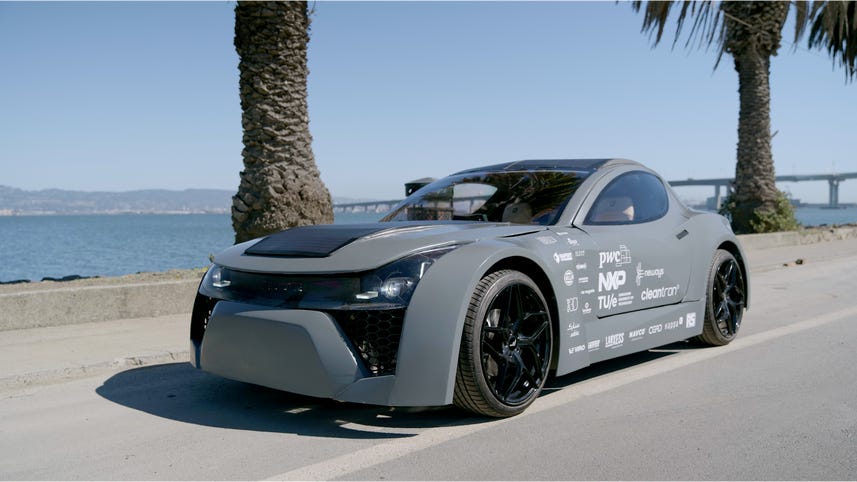
Speaker 1: You're looking at what could be the world's first carbon negative vehicle. This is Zem. Now, Zem actually collects more carbon than it emits, so let's go take it for a red news flash. The world is facing a [00:00:30] carbon crisis. Even though global carbon emission growth is slowing, we're still on pace to omit more carbon in 2022 than any year in human history. And despite misconceptions, you may have heard about cattle and agriculture, the worst polluters in the United States are, you guessed it. Vehicles, planes, trains, and yes, our cars and trucks. But what it's getting in your car and taking a long drive didn't fuel climate change. It actually reduced your car footprint. That [00:01:00] reality isn't here for most of us just yet, but a group of college students proved it's not impossible. Meet Zem or zero emission mobility concept car built from the ground up to be not just carbon neutral, but carbon negative.
Speaker 2: Zem is, to our knowledge the most sustainable gar in the world right now.
Speaker 1: Zem is the brainchild of 35 students from I Hoven, University of Technology in the Netherlands. They spent the last year conceptualizing, designing and building them [00:01:30] to be sustainable through its entire life cycle. We caught up with them in San Francisco on Zen's three month tour of the US there was a laundry list of features and technologies that make this car green. But let's start with what you are probably wondering. How does this car clean the atmosphere? It's thanks to two carbon dioxide filters the team designed and installed behind the front grill. I should note, they couldn't show us the filters because the team is trying to patent the technology. As Zem drives carbon sticks to a special grain [00:02:00] inside the filter. As air passes through the team estimates Zem can capture four and a half pounds of CO2 every 20,000 miles driven. That may not seem like a lot, but about 10 zens on the road would capture as much carbon as an average tree. Now imagine if even just 10% of the 275 million registered vehicles in the US had this technology that would be like planting nearly 3 million trees.
Speaker 2: When these filters can be made, moderately can be implemented in [00:02:30] every type of vehicle, every kind of transportation, all small bits will eventually become a big snowball and help the greenhouse emissions.
Speaker 1: Once the filters are full, after about 200 miles, the team says they can be emptied and the carbon can be put to use,
Speaker 2: For example, in the process of making beer. So instead of having the carbon dioxide open in the air where we don't need it, we can actually use it on useful purposes.
Speaker 1: That's right. The carbon your zem captures could one day become an [00:03:00] ice cold beer. The chassis is 3D printed, made completely from recycled plastic. That interior that's made from pineapples, also known as vegan leather. The dash is made from recycled cooking oils. Solar panels on the roof in the hood generate about 15% of them's power. It also has a traditional plug-in connection behind the rear license plate to help charge the eight batteries. The team implemented bidirectional charging technology into zem, meaning you could use it as a generator to power your appliances [00:03:30] in your home. Of course, a major part of a vehicle's environmental impact is what happens to it at the end of its life. The Z team says everything here can be recycled. Starting with the plastic frame, which can be shredded and reused for 3D printing, those them is nowhere near hitting a production line anytime soon. The team hopes its work can inspire others, particularly those with more resources and deeper pockets.
Speaker 2: What we can do as a team of 30 fives undergraduate students [00:04:00] a big company with a full department of bright engineers can do way better.
Speaker 1: Carbon capture is expected to become big business in the next few years. Analysts estimate it will be a 7 billion industry by 2028. We have several videos on carbon capture technologies. I'll put links to them down in the description. We were supposed to take a full ride in zem. Unfortunately, that couldn't happen as can be expected with any sort of concept vehicle. They were experiencing some technical difficulties with the steering. [00:04:30] Now, of course, this isn't meant to be a production vehicle. This is a proof of concept meant to prove that a car can be 100% sustainable. So I want to know what you think. What do you think of them? Let me know down in those comments below. If you enjoyed this video, please don't forget to give it a thumbs up and subscribe to CNET for more like it.